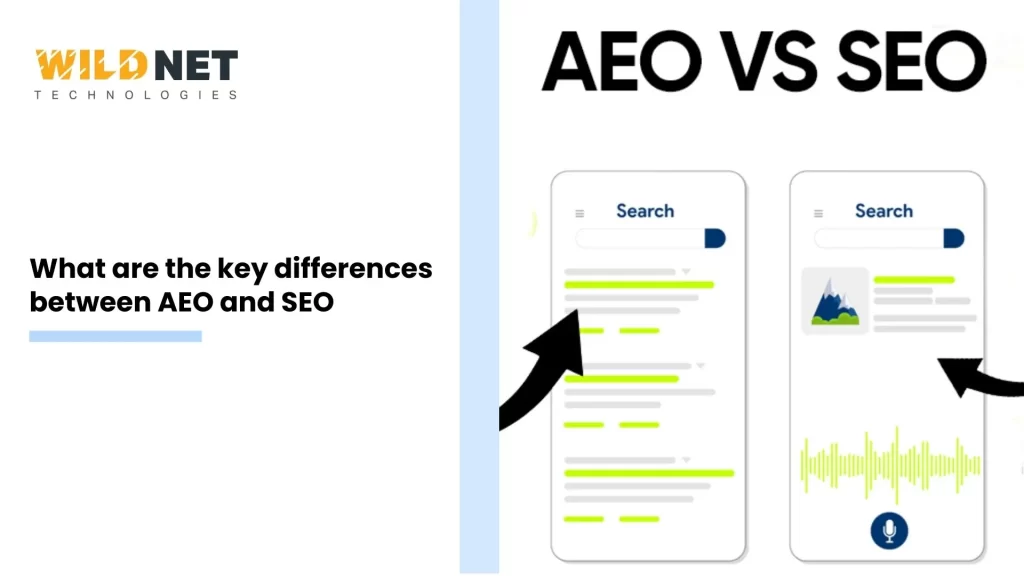Search Engine Optimization, or SEO, is a fundamental digital marketing strategy designed to enhance a website’s visibility on search engines like Google, Bing, and Yahoo.
The core objective of SEO is to secure higher rankings on search engine results pages (SERPs) for specific keywords, consequently driving organic traffic to the website. This strategy is crucial for businesses seeking to increase their online presence and attract potential customers actively searching for information, products, or services. What are the key differences between AEO and SEO? While SEO focuses on improving visibility through keyword optimization and backlinks, AEO targets answer engines and voice assistants by structuring content to provide clear, direct responses.
SEO is structured around several key components, each playing a vital role in achieving optimal search engine rankings:
- Keyword Research involves identifying and targeting potential customers’ keywords when searching for products or services. Effective keyword research ensures that content aligns with user intent and search queries, improving the chances of ranking higher in SERPs.
- On-Page Optimization: This involves enhancing individual pages’ content and HTML source code to improve their relevance and visibility. Elements such as meta tags, headings, and image alt texts are optimized for relevant keywords to ensure search engines can easily understand and categorize the content.
- Off-Page Optimization: Building backlinks from reputable websites increases the site’s authority and trustworthiness. High-quality backlinks act as endorsements from other websites, signaling to search engines that the content is valuable and reliable.
- Technical SEO: This focuses on improving the website’s technical aspects, such as site speed, mobile-friendliness, and indexing, to ensure search engines can easily crawl and understand the content. Technical SEO ensures the website is accessible and functions smoothly, providing a seamless user experience.
Answer Engine Optimization, or AEO, is a relatively new concept that focuses on optimizing content for answer engines like virtual assistants and voice-activated devices. With the rise of smart speakers and voice searches, AEO has gained significant importance. Unlike traditional SEO, which focuses on ranking in SERPs, AEO aims to provide direct answers to user queries, making it easier for voice assistants to fetch and deliver relevant information.
AEO involves several key components, each crucial for optimizing content for voice-based searches:
- Structured Data: Implementing schema markup helps search engines understand the content context and extract precise answers. Structured data provides a way to label content, making it easier for search engines to interpret and present information accurately.
- Concise Content: AEOs must create content that directly answers common questions in a clear and concise manner. Since voice searches are often conversational, concise answers improve the likelihood of being featured in voice assistant responses.
- Contextual Relevance: Ensuring content is contextually relevant to user queries and delivers accurate information is essential for AEO success. Understanding the intent behind user queries and tailoring content accordingly enhances its relevance and usefulness.
- Voice Search Optimization: Tailoring content to cater to conversational queries often used in voice searches is a critical aspect of AEO. This involves understanding the natural language patterns used in voice searches and crafting content that aligns with those patterns.
While both AEO and SEO aim to improve online visibility, they differ in their approach and execution, catering to different aspects of search optimization.
SEO primarily targets users searching for information, products, or services through traditional search engines. These users typically type specific queries into search bars, seeking detailed information and exploring multiple sources. What are the key differences between AEO and SEO? While SEO caters to this type of search behavior, AEO is designed for users who rely on voice-activated devices and virtual assistants, expecting immediate, concise answers rather than browsing several webpages.
These users often pose conversational queries, expecting quick, direct responses without sifting through multiple search results. This difference in target audience influences how content is created and optimized, with AEO requiring a more conversational and concise approach.
SEO content often includes long-form articles, blogs, and web pages rich with keywords and information. These formats provide in-depth insights and cater to users who prefer detailed explanations. AEO, on the other hand, prioritizes concise, to-the-point content that can be easily interpreted and delivered by voice assistants. This involves crafting content that answers questions directly and succinctly, ensuring that voice assistants can easily retrieve and read the information aloud.
SEO relies heavily on keyword optimization, backlinks, and technical improvements to enhance search engine rankings. These techniques are designed to improve the website’s authority and relevance in the eyes of search engines.
AEO emphasizes structured data and contextually relevant content that directly answers user queries. AEO ensures content is optimized for voice-based interactions by delivering precise answers and employing structured data.
Optimizing for Visibility and Voice: The Role of SEO and AEO
SEO aims to place content higher in traditional search results, allowing users to click through and explore a website. This involves optimizing content to appear prominently in SERPs, attracting clicks from users seeking detailed information. AEO focuses on providing direct answers, often featuring content in position zero or as featured snippets, where voice assistants can easily retrieve and read the information aloud. This approach prioritizes delivering quick answers, catering to users who seek immediate solutions to their queries.
Why AEO and SEO Must Work Together
AEO and SEO are crucial for a comprehensive search optimization strategy in the digital age. As more users turn to voice search for quick answers, businesses need to adapt and ensure their content is optimized for both text-based and voice-based searches.
The Voice Search Revolution and Changing User Behavior
The rise of voice search has reshaped how users interact with technology. As voice-activated devices become more prevalent, users expect swift, accurate responses to their queries. By embracing AEO alongside traditional SEO practices, businesses can reach a wider audience, cater to evolving search behaviors, and maintain a competitive edge in the digital marketplace. This dual approach ensures businesses remain relevant and accessible to users across different platforms and search preferences.
Enhancing User Experience Through Dual Optimization
Both AEO and SEO contribute to an improved user experience. While SEO helps users discover websites with valuable information, AEO ensures that users receive quick, accurate answers to their queries, enhancing overall satisfaction. By providing comprehensive information through SEO and immediate answers through AEO, businesses can create a seamless user journey that meets diverse user needs and expectations.
Implementing effective AEO and SEO strategies requires a thoughtful approach and careful planning. Here are some actionable steps to get started:
- Conduct Comprehensive Keyword Research: Identify keywords that align with your business goals and target audience. Use tools and analytics to understand search trends and user intent, ensuring your content addresses the needs of your audience.
- Optimize On-Page Elements: Ensure your web pages are well-structured, with meta tags, headings, and image alt texts optimized for relevant keywords. This enhances the content’s relevance and makes it easier for search engines to index and rank your pages.
- Build Quality Backlinks: Focus on acquiring backlinks from authoritative websites to enhance your site’s credibility and authority. Engage in outreach and partnerships to secure valuable links that boost your site’s reputation.
- Enhance Technical SEO: Improve site speed and mobile responsiveness, and ensure proper indexing for optimal search engine performance. Regularly audit your website’s technical aspects to identify and address issues hindering search engine crawling and indexing.
- Implement Structured Data: Use schema markup to help search engines understand your content and extract direct answers. Structured data enhances the visibility of your content in voice search results, making it more accessible to voice assistants.
- Create Concise Content: Craft content that directly answers common questions clearly and concisely. Focus on delivering valuable insights quickly, ensuring your content is easily digestible for voice-activated devices.
- Optimize for Voice Search: Tailor content to cater to conversational queries and natural language used in voice searches. Analyze how users phrase questions verbally and adjust your content to match these patterns, improving its relevance and accessibility.
- Monitor and Adapt: Regularly analyze performance metrics and adapt your strategies to align with evolving search trends. Monitor industry developments and user behavior changes to ensure your plan remains effective and competitive.
In conclusion, while AEO and SEO aim to enhance online visibility, they differ significantly in their approach and execution. What are the key differences between AEO and SEO? Understanding these distinctions allows businesses to craft a well-rounded digital marketing strategy that addresses the needs of both traditional search engine users and those relying on voice-activated assistants. By integrating AEO and SEO techniques, businesses can improve their chances of being discovered through typed queries or spoken ones. An experienced SEO company in India can help implement this dual strategy effectively, ensuring optimized content delivery across all platforms. As the digital landscape continues to evolve, staying adaptable and informed will be crucial for businesses seeking to thrive in an increasingly competitive online environment.
FAQs
Q. What is the main difference between AEO and SEO?
Ans. SEO optimizes content for traditional search engines like Google to rank higher on SERPs (Search Engine Results Pages). AEO, on the other hand, is about structuring content so that it can be easily understood and directly answered by AI-powered assistants like Google Assistant, Alexa, and ChatGPT.
Q. How does user intent differ in AEO and SEO?
Ans. SEO often targets both informational and transactional intent for users browsing websites. AEO prioritizes immediate, concise answers to specific questions, matching conversational queries users ask voice assistants or chatbots.
Q. What type of content works best for AEO compared to SEO?
Ans. AEO benefits from content that provides direct answers using structured data, FAQs, and schema markup. SEO content can be broader, including long-form articles, blogs, and keyword-optimized web pages for organic ranking.
Q. Which technologies or tools support AEO that are not commonly used in SEO?
Ans. AEO heavily relies on structured data markup (like JSON-LD), voice search optimization, and NLP (Natural Language Processing) tools to align content with how AI engines interpret queries. SEO uses tools like keyword planners, backlink analyzers, and site audits.
Q. Can AEO and SEO work together or separate strategies?
Ans. Yes, they complement each other. While SEO ensures visibility on traditional search engines, AEO helps content surface in answer boxes and AI-generated responses. Together, they strengthen a brand’s digital presence across search and conversational platforms.
Read more
Decoding AEO & Redefining the Future of SEO!
AEO and SEO: Choosing the Right Strategy
Forget SEO: Use Search Experience Optimization, AEO, GEO & AIO for Full Visibility
The Future of SEO is AEO (Answer Engine Optimization)!






